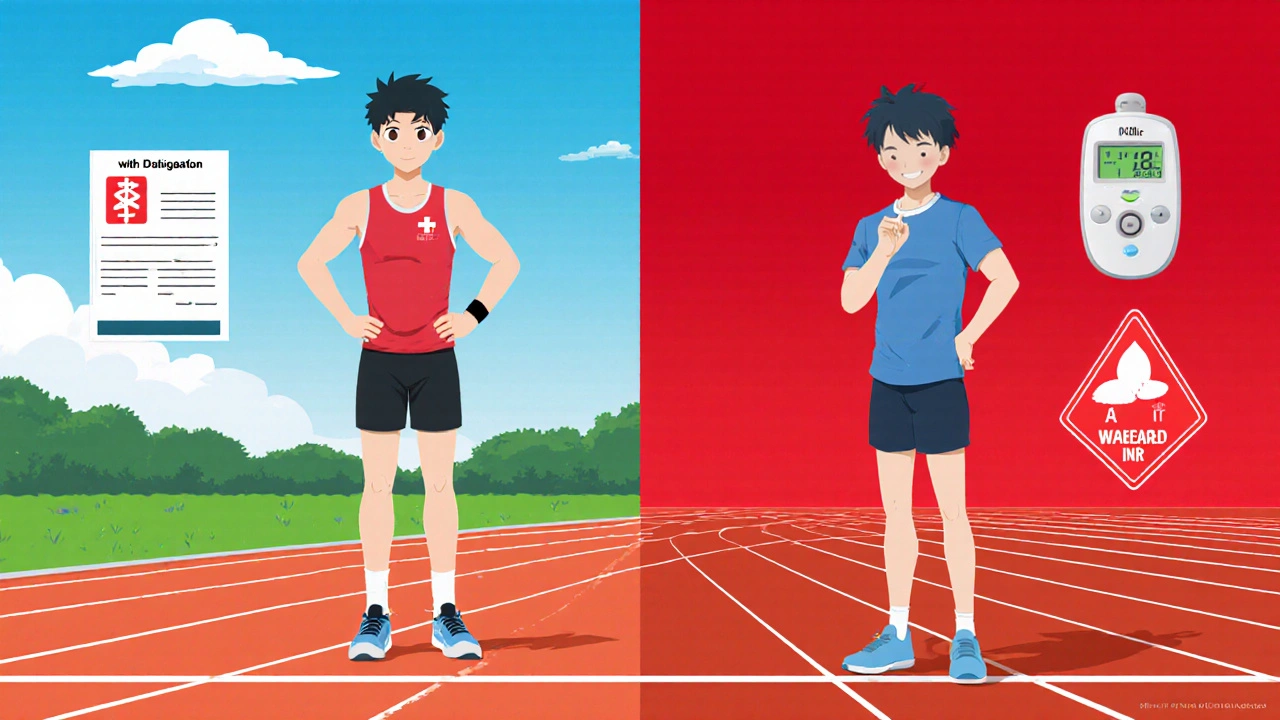Bleeding Risk Assessment Tool
Assess Your Exercise Safety
Enter your exercise details below to determine your personalized bleeding risk level while taking Dabigatran.
Your Personalized Assessment
When athletes are prescribed Dabigatran, a direct thrombin inhibitor, they often wonder how it fits with their training routine. The drug’s brand name is Pradaxa, and it’s commonly used to prevent strokes in people with atrial fibrillation or to treat deep‑vein thrombosis. dabigatran and exercise can coexist, but you need to understand the science, the risks, and the practical steps to stay safe on the track, field, or gym floor.
How Dabigatran Works
Dabigatran blocks the activity of thrombin, an enzyme that converts fibrinogen into fibrin - the main protein that forms blood clots. By inhibiting thrombin, the medication reduces the chance of clots forming in the heart or veins, which in turn lowers the risk of stroke or pulmonary embolism. Unlike older anticoagulants such as Warfarin, dabigatran has a predictable effect, doesn’t require routine INR monitoring, and reaches peak levels about 2 hours after a dose.
Why Exercise Matters for Anticoagulated Athletes
Physical activity improves cardiovascular health, muscle strength, and overall well‑being - all things that benefit someone on an anticoagulant. Exercise also helps maintain healthy blood flow, which can reduce the likelihood of clot formation in the first place. However, high‑intensity or contact sports raise the chance of minor injuries that could bleed more than usual when you’re on dabigatran.
- Endurance sports (running, cycling, swimming) usually pose a lower bleeding risk than contact sports.
- Weight‑bearing and strength training can cause muscle micro‑tears; these heal faster with good nutrition and proper rest.
- Contact sports (football, rugby, martial arts) have the highest potential for bruises, cuts, and internal bleeding.
Understanding where your sport falls on this spectrum helps you decide on training modifications.
Bleeding Risks and How to Manage Them
Bleeding is the main side effect of any anticoagulant. With dabigatran, the most common issues are nosebleeds, gum bleeding, and easy bruising. Serious bleeding, such as gastrointestinal or intracranial hemorrhage, is rare but possible, especially if you have kidney impairment or are taking interacting drugs.
- Know your baseline. Before you start training, track how often you bruise or bleed with a simple diary.
- Watch for red‑flag symptoms. Sudden severe headache, blood in urine or stool, or prolonged bleeding after a cut require immediate medical attention.
- Stay hydrated. Good hydration supports kidney function, which clears dabigatran from the body.
- Protect vulnerable areas. Use mouthguards, shin guards, and padded gloves during high‑impact activities.
Most athletes can continue training safely by following these precautions and keeping regular check‑ups with their healthcare provider.

Practical Tips for Training on Dabigatran
Here’s a checklist you can paste onto your phone or gym board:
- Take dabigatran with a full glass of water, preferably at the same time each day.
- Avoid high‑dose vitamin K supplements; they don’t interfere with dabigatran like they do with warfarin, but sudden dietary changes can affect overall clotting balance.
- Schedule intense workouts for the morning if you take your dose at night - you’ll have a lower plasma concentration during the session.
- Include protein‑rich foods (lean meat, beans, Greek yogurt) to help maintain muscle repair, especially since dabigatran can slightly increase creatine kinase levels after strenuous exercise.
- Monitor your Renal function annually; reduced kidney clearance raises dabigatran levels and bleeding risk.
- Carry a medical ID that lists dabigatran as your anticoagulant - emergency responders need to know.
These habits keep you in control and make it easier for your doctor to adjust dosage if needed.
Comparing Dabigatran and Warfarin for Active Lifestyles
| Factor | Dabigatran (Pradaxa) | Warfarin (Coumadin) |
|---|---|---|
| Monitoring | No routine INR checks; occasional renal labs | Regular INR testing required |
| Dietary restrictions | None specific; maintain consistent water intake | Strict vitamin K control |
| Half‑life | 12‑17 hours (steady‑state) | 20‑60 hours (high variability) |
| Bleeding pattern | Gastrointestinal bleeding more common | Intracranial bleeding risk slightly higher |
| Impact on training | Predictable effect; easier timing around workouts | Fluctuating INR can limit high‑intensity sessions |
For most athletes, dabigatran’s predictable profile makes it the smoother choice, especially if you dislike frequent blood draws. Warfarin may still be preferred in patients with severe kidney disease, as it isn’t cleared renally.

Monitoring and Medical Check‑ups
Even though dabigatran doesn’t need INR monitoring, you should still schedule regular labs:
- Renal function (eGFR) - at least once a year, more often if you have diabetes or hypertension.
- Complete blood count (CBC) - checks hemoglobin and platelet levels; a sudden drop can indicate hidden bleeding.
- Liver enzymes - dabigatran is metabolized minimally by the liver, but concurrent liver disease can affect drug handling.
If you notice any of the red‑flag symptoms mentioned earlier, contact your doctor right away. In emergencies, the reversal agent idarucizumab (Praxbind) can neutralize dabigatran within minutes.
Frequently Asked Questions
Can I run a marathon while on dabigatran?
Yes, many marathoners use dabigatran without issues. Plan your dosing so the drug’s peak level (about 2 hours after intake) occurs after the race, and stay hydrated throughout.
Should I avoid contact sports?
Contact sports increase the chance of severe bruising or internal bleeding. If you choose to play, use full protective gear and discuss dose adjustments with your physician.
What happens if I miss a dose before a competition?
Take the missed dose as soon as you remember, unless it’s within 6 hours of the next scheduled dose. Skipping a dose can raise clot risk, which is more dangerous for endurance athletes.
Can supplements like fish oil interact with dabigatran?
High doses of omega‑3 fatty acids may slightly increase bleeding time. Talk to your doctor before adding large amounts of fish oil or other blood‑thinning supplements.
Is it safe to travel for a competition while on dabigatran?
Travel poses no extra risk as long as you keep the medication in its original container, stay hydrated, and avoid extreme heat that could affect kidney function.
By understanding how dabigatran works, monitoring your health, and tailoring your training plan, you can stay competitive without compromising safety. Remember: the goal isn’t to stop exercising, but to exercise smartly while keeping your blood clot risk in check.


From an ethical standpoint, the integration of dabigatran into an athlete's regimen must be approached with rigorous pharmacodynamic scrutiny. The literature often glosses over the iatrogenic bleeding potential while glorifying performance metrics, which is simply indefinate. Athletes should not ignore the hemostatic modulation that accompanies thrombin inhibition, lest they end up in a preventable medical crisis. Remember, the responsibility lies not just with the clinician but also with the individual who choses to push limits without proper risk assessment. Dont compromise long‑term health for short‑term gains.
Dear fellow athletes, it is my sincere pleasure to commend your dedication to maintaining cardiovascular health whilst navigating anticoagulation therapy. As a coach, I advocate for meticulous scheduling of training sessions to align with the pharmacokinetic peaks of dabigatran, thereby minimizing hemorrhagic risk. Please ensure adequate hydration and protective equipment, particularly when engaging in high‑impact disciplines. Your commitment to both safety and excellence serves as an exemplar for the sporting community. I remain at your disposal for any further guidance.
While the article offers a cursory overview of dabigatran’s pharmacology, it conspicuously omits the broader machinations of pharmaceutical lobbying that subtly shape clinical guidelines. One might wonder whether the authors were commissioned by vested interests to downplay the latent hemorrhagic contingencies inherent in thrombin inhibition. The narrative, albeit polished, suffers from a lazy lack of critical depth, rendering it a mere reiteration of manufacturer‑approved talking points. A truly erudite examination would have interrogated the epistemic foundations of these recommendations.
Listen up, folks – the whole “safe exercise on dabigatran” storyline feels like a script written by a secret board that wants us to believe we’re invincible. You train hard, you trust the drug, and then boom – a hidden bleed could sideline you without warning. It’s almost theatrical how the risks are downplayed, like a drama where the villain is unseen. Just keep your guard up, because the plot twists are real.
Dabigatran is primarily eliminated via renal excretion, with approximately 80% of the administered dose cleared unchanged in the urine. Consequently, any decline in glomerular filtration rate can markedly increase plasma concentrations, raising the bleeding propensity. The drug reaches steady‑state after three to five doses, and its half‑life extends from 12 to 17 hours in individuals with normal renal function. Dose adjustments are therefore recommended for patients with eGFR below 30 mL/min. Monitoring renal parameters annually is a prudent practice for athletes on chronic therapy.
It is incumbent upon every athlete who elects to incorporate dabigatran into their daily regimen to adopt a holistic perspective that transcends mere performance metrics. The first principle is an unwavering commitment to understanding the drug’s mechanistic impact on thrombin activity and the downstream effects on hemostasis. Secondly, one must recognize that the temporal relationship between dosing and peak plasma concentrations dictates optimal training windows, a nuance that cannot be ignored without courting unnecessary peril. Third, the ethical dimension of self‑care demands that individuals refrain from glorifying risk‑taking behaviors that could jeopardize their long‑term vascular integrity. Fourth, vigilant self‑monitoring for subtle signs of bleeding-such as unexplained bruising, epistaxis, or hematuria-constitutes a non‑negotiable safeguard. Fifth, the incorporation of protective gear tailored to specific sports serves as a practical barrier against traumatic insults that the anticoagulated state amplifies. Sixth, adequate hydration must be maintained to support renal clearance, thereby mitigating drug accumulation. Seventh, athletes should engage in periodic dialogues with healthcare providers to reassess dosing in the context of evolving training loads. Eighth, the judicious use of nutrition, particularly protein‑rich foods, aids in muscle repair, which is essential given the minor micro‑tears that can occur during strength training while on anticoagulation. Ninth, any deviation from the prescribed dosing schedule-whether intentional or accidental-necessitates immediate correction to avoid sub‑therapeutic clot prevention. Tenth, the societal responsibility of athletes to model safe practices cannot be overstated, as their influence extends beyond personal achievement. Eleventh, when participating in contact sports, an exhaustive risk–benefit analysis should be conducted, weighing the heightened hemorrhagic potential against competitive aspirations. Twelfth, awareness of drug–drug interactions, especially with non‑steroidal anti‑inflammatory agents, is vital to prevent additive bleeding risks. Thirteenth, the availability of a reversal agent, idarucizumab, should be communicated to coaching staff and emergency responders, ensuring rapid response in exigent circumstances. Fourteenth, documentation of training metrics alongside anticoagulation parameters creates a valuable dataset for individualized care. Finally, by integrating these comprehensive strategies, athletes can pursue excellence without compromising safety, thereby embodying the true spirit of disciplined sport.
It is valuable to acknowledge the diverse cultural attitudes toward medical compliance, especially when athletes from various backgrounds integrate dabigatran into their routines. Respecting these perspectives enriches the conversation about safe training practices.
Training on dabigatran can be done safely if you plan workouts around dosing and stay hydrated always.
Do not ignore the red‑flag symptoms; they are your body’s alarm system.
I hear the concerns raised earlier and want to stress that open communication with your medical team can ease anxieties and tailor a plan that fits your unique training goals.
Sharing experiences across cultures helps us all improve safety standards in sport.
While many laud the convenience of dabigatran, one must consider that reliance on foreign pharmaceuticals diminishes our commitment to domestic health innovation and may expose American athletes to unforeseen complications.
Remember, you are not alone in navigating these challenges; the community stands ready to support you every step of the way.